You should try commuting by bike
You should try commuting by bike because it’s good for the environment, could save you money and you get a daily dose of exercise at the same time. I work from home most of the time with only one day in the office. My office is too far away to commute by bike but if your workplace is within about 20 km or so of your home, commuting by bike could be a great option.
Women tend to approach cycling differently to men (please excuse the stereotyping) and that includes bike commuting. A lot of men treat commuting like a race and constantly attempt to outdo their previous times and those of other riders. Women, however, tend to treat it more like a practical way to get to work and are more focused on safety than speed. So naturally women have a few ‘special’ requirements.
To me it’s all in the planning. Here are a few tips I’ve compiled to get you started.
What bike?
Ideally you want a bike that’s not worth thousands of dollars, particularly if you need to leave it in a communal storage area or even tethered to a post during the day. You might have an old bike that you haven’t touched since you bought your lovely road or mountain bike, or you could consider buying a dedicated commuting bike like a hybrid or flat bar road bike.
The other fabulous option that is growing in popularity is an e-bike. They are great for commuting because you don’t arrive at work lathered in sweat, particularly if your commute involves hills.
When I did live closer to my workplace, I tried commuting and even bought a dedicated hybrid bike. I hated it. It was heavy and didn’t have enough gears. I had obviously grown too used to my lightweight road bike and it just didn’t measure up. Instead, I traded it for a gravel style road bike and was much happier. Go with what works best for you.
Plan your route
There can be several ways to get from point A to point B and it’s not necessarily going to be the same route that you’d take in a car.
Women cyclists are far more likely to choose routes based on their enjoyment and safety, rather than because the route is faster, flatter or efficient. And that’s okay. The most important thing is that you feel comfortable and safe. It’s a great idea to do a rehearsal and ride the route on the weekend when there are less people around and you’re not under pressure to arrive by a certain time.
Before I started commuting, I studied the map and then I drove the route to make sure it was going to work for me. I also modified it over time because the original route I chose included about four schools which is not ideal when parents are dropping children off by car.
You should also think about a wet weather contingency, mine was a car. If you don’t like the idea of riding on a rainy day, then you’ll need a public transport or even car alternative for those days.
Learn some basic maintenance and carry tools & spares
Particularly if you commute on your own, you need to know some basic maintenance for your bike like fixing a flat tyre and putting a chain back on. You also need to carry a spare tube, a pump or gas cylinders and a few basic tools. And of course, it goes without saying that you should always carry a mobile phone in case you need to call for help.
Light up
Having good visible front and back lights is essential particularly if you leave early in the morning and return home in the dark. Even in full daylight lights are important to ensure that motorists, other cyclists, and pedestrians can always see you. Make sure that the batteries are charged the night before or that you’ve replaced the batteries if necessary.
I used one good quality front light and three rear lights – one on my helmet and two on my bike. I don’t think you can ever be visible enough when you are riding on your own on roads.
Plan your clothing and grooming items
There are two sets of clothing you need to plan – your riding gear and your work attire. This is a personal choice for both.
Firstly, your riding gear. I think it’s more important to be seen than to be fashionable when you’re commuting so you might consider a fluoro top and vest or at least a light colour. You need to consider different seasons and dress according to your own weather conditions and carry a lightweight rain jacket for that unexpected downpour.
For your work clothing it really depends on how you dress for work. If you wear clothes that need ironing like a work suit and blouse, then you could make a once-a-week trip to work to drop off your clothes for the week and get changed when you reach the office. It’s all in the planning.
I wore quite casual clothes to work so I rode in my work pants and shoes and just changed my top when I got to work.
Some women manage to squeeze their work attire (it’s a good idea to roll your clothes rather than fold them) and grooming items into a backpack and carry it with them. You also need to consider ‘helmet hair’ which is unavoidable but can sometimes be saved with a bit of a carefully applied hair product.
Many companies also offer a pick-up and delivery service for dry cleaning from workplaces which can work well for bike commuters.
Many forward-thinking employers now offer bike lockers and grooming facilities but if yours doesn’t there may be some facilities nearby like a local gym or shopping centre where you can shower and even store your bike. Plus, if your commute is short, you might get away without having a shower when you get to work.


